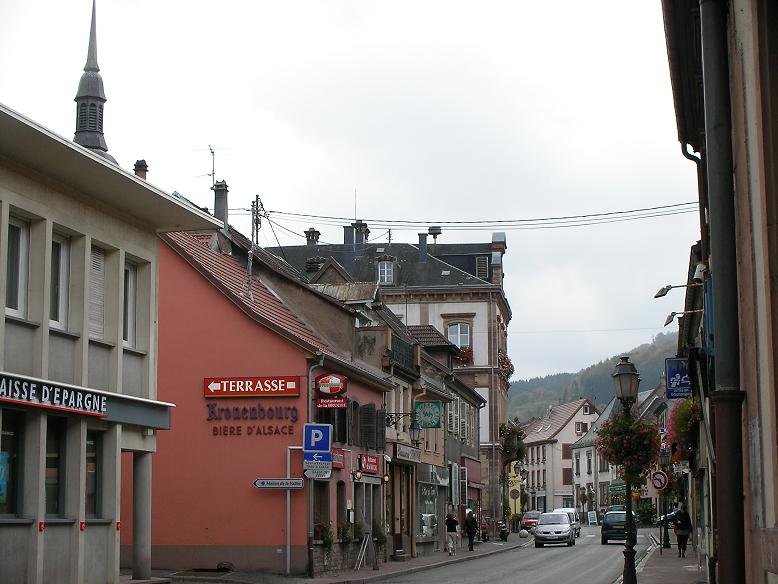Schirmeck on:
[Wikipedia]
[Google]
[Amazon]
Schirmeck () is a  It is the location of the Alsace-Moselle Memorial museum.
The name of the town means "protected place". In Lorraine dialect it is called "Chermec".
The inhabitants are known as "Schirmeckois".
It is the location of the Alsace-Moselle Memorial museum.
The name of the town means "protected place". In Lorraine dialect it is called "Chermec".
The inhabitants are known as "Schirmeckois".
commune
A commune is an alternative term for an intentional community. Commune or comună or comune or other derivations may also refer to:
Administrative-territorial entities
* Commune (administrative division), a municipality or township
** Communes of ...
in the Bas-Rhin
Bas-Rhin (; Alsatian: ''Unterelsàss'', ' or '; traditional german: links=no, Niederrhein; en, Lower Rhine) is a department in Alsace which is a part of the Grand Est super-region of France. The name means 'Lower Rhine', referring to its low ...
department in Grand Est
Grand Est (; gsw-FR, Grossa Oschta; Moselle Franconian/ lb, Grouss Osten;
Rhine Franconian: ''Groß Oschte''; german: Großer Osten ; en, "Great East") is an administrative region in Northeastern France. It superseded three former administra ...
in north-eastern France
France (), officially the French Republic ( ), is a country primarily located in Western Europe. It also comprises of overseas regions and territories in the Americas and the Atlantic, Pacific and Indian Oceans. Its metropolitan area ...
.
Geography
The town is situated on the banks of the Bruche, in theVosges
The Vosges ( , ; german: Vogesen ; Franconian and gsw, Vogese) are a range of low mountains in Eastern France, near its border with Germany. Together with the Palatine Forest to the north on the German side of the border, they form a single ...
mountains. The commune extends over 1142 hectares from the Petit Donon to the Bruche, from the Grandfontaine stream to the Tommelsbach stream, taking in the Evêché hills, 832m high.
The area is mountainous and belongs to the Devonian Dinant primary rocks, made up of a series of schist
Schist ( ) is a medium-grained metamorphic rock showing pronounced schistosity. This means that the rock is composed of mineral grains easily seen with a low-power hand lens, oriented in such a way that the rock is easily split into thin flakes ...
s and grauwackes in an irregular flow created at the bottom of a sea that was shaken by volcanic eruptions. Most of the territory is covered by forest, on steep slopes, but rich in mineral deposits, particularly iron and manganese
Manganese is a chemical element with the symbol Mn and atomic number 25. It is a hard, brittle, silvery metal, often found in minerals in combination with iron. Manganese is a transition metal with a multifaceted array of industrial alloy use ...
.
The town is narrowly confined between the mountain side and the Bruche river, so a 610-metre road tunnel has been built in order to relieve traffic congestion. The bypass was opened on 28 January 2007.
History
First mention
In 1315, the town was mentioned as Schirmecke in a founding charter of the collegial church of Haslach ( Niederhaslach). It reappeared in the description of the boundaries of the lands of the abbey of Senones, under the name ''Neufville en Barembax''; the name "new town" suggesting that it had recently been created. The town was hardly more than village, without any known privileges such as markets or freedoms. It was dependent on the See of Strasbourg but nevertheless occupied a strategic position on the Bruche, at the crossing of busy roads linking Alsace to Lorraine. The German name Schirmeck (''opido nostro Schirmeck'') was only adopted in the acts of chancelry from 1348.From the Middle Ages to the Renaissance
The lands on which the town grew up was a former possession of the Counts of Nordgau, acquired from the last of the line, Frederick of Leiningen (Linange) in 1239 by Berthold I of Teck, bishop of Strasbourg. It was towards the end of the thirteenth century that it became a town, without having that status. The Bishop of Strasbourg Johann 1st of Dirpheim (1308-1328) surrounded it by walls that were still in place in 1666, and built a bishop's castle. The castle and town controlled a strategic passageway betweenAlsace
Alsace (, ; ; Low Alemannic German/ gsw-FR, Elsàss ; german: Elsass ; la, Alsatia) is a cultural region and a territorial collectivity in eastern France, on the west bank of the upper Rhine next to Germany and Switzerland. In 2020, it had ...
and the Duchy of Lorraine
The Duchy of Lorraine (french: Lorraine ; german: Lothringen ), originally Upper Lorraine, was a duchy now included in the larger present-day region of Lorraine in northeastern France. Its capital was Nancy.
It was founded in 959 following th ...
. A toll for crossing the Bruche was mentioned for the first time in 1350. By this time a municipal government structure was in place, headed by a Schultheiß, an officer representing the bishop. An equally important toll was set up on the pass between the Great and Small Donon. Through there several thousand heads of cattle passed in fifty years, according to a witness statement made by an inhabitant of Harbouey in 1579. Long-distance trade routes linking the animal markets of Frankfurt, Strasbourg and Nuremberg brought wine, fish, cereals, ironmongery, sheep, pigs, oxen and horses through the town.